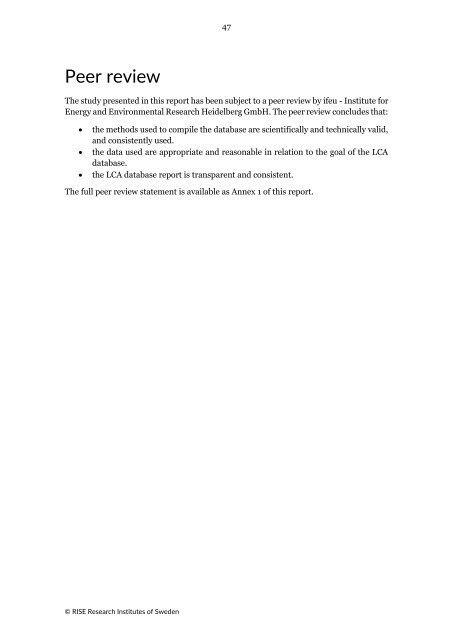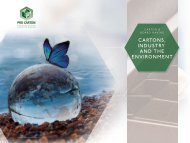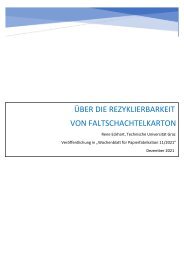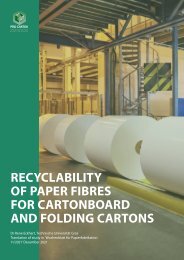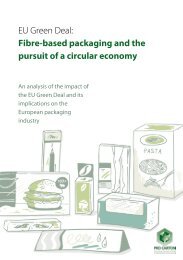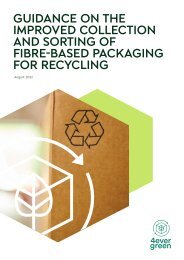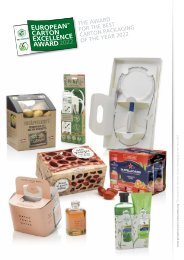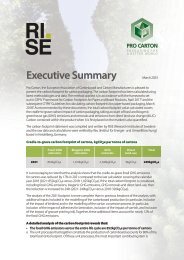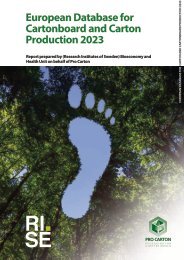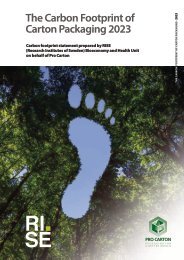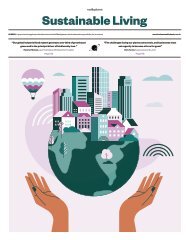European database for cartonboard and carton production, 2023
Create successful ePaper yourself
Turn your PDF publications into a flip-book with our unique Google optimized e-Paper software.
44<br />
surveys, it is no longer necessary to calculate net energy consumption at the mills <strong>and</strong>/or<br />
provide a credit <strong>for</strong> sold energy. This approach should result in a more consistent life<br />
cycle inventory which is easier to interpret<br />
• For purchased pulp, pulp nomenclature was clarified, resulting in consistent naming of<br />
different pulp types across the survey<br />
• For non-fibre inputs, data was requested on the dry mass percentage of the input to<br />
ensure that the consumption is always considered according to the active substance. Data<br />
was also requested regarding the transport distances <strong>and</strong> modes of transport <strong>for</strong> nonfibre<br />
inputs, resulting in a more complete underst<strong>and</strong>ing of transport associated with the<br />
raw materials consumed by the paper mills<br />
• For water consumption, inputs of sea/coastal waters were requested. Similarly, releases<br />
of water to sea/estuaries were requested. This in<strong>for</strong>mation may be important as the<br />
impact assessment categories <strong>for</strong> water develop<br />
• Further detail was requested regarding the management of residues arising from the<br />
paper mills. Previous experience with life cycle data providers has shown that<br />
assumptions regarding the management of some residues streams (particularly organic<br />
sludges, lime mud, green liquor dregs <strong>and</strong> calcium carbonate) can be very influential on<br />
the results achieved when using the gate-to-gate life cycle inventories to compile cradleto-gate<br />
life cycle inventories. In particular, assumptions that these residue streams are<br />
sent to l<strong>and</strong>fill <strong>and</strong>/or incineration can contribute significantly to the impact assessment<br />
results achieved. Collecting more detailed data relating to the management of residue<br />
streams has demonstrated that in fact the vast majority of residues arising at the paper<br />
mill are reused <strong>and</strong> recycled in some way.<br />
Trends in key environmental parameters<br />
The life cycle inventory presented in Table 2 represents the average <strong>European</strong> <strong>production</strong><br />
of <strong><strong>carton</strong>board</strong> <strong>and</strong> <strong>carton</strong>s, based on the data received during from mills <strong>and</strong> plants<br />
participating in the 2021 survey. As previously explained, the coverage of the market is<br />
noticeably increased <strong>for</strong> the 2021 survey compared to the 2018 survey. Whilst this means<br />
that the life cycle inventory presented in this version of the report is more representative<br />
of the weighted <strong>European</strong> average <strong>production</strong>, it also means that care should be taken<br />
when comparing this current inventory directly with previous versions of the dataset.<br />
If mills with large <strong>production</strong> capacity join the survey or drop out of the survey, then<br />
changes in the coverage of the papermills participating in the survey can be influential<br />
on the results achieved. This should be borne in mind when comparing the results of the<br />
2021 survey <strong>and</strong> the 2018 survey.<br />
Nonetheless, it is still valuable <strong>and</strong> in<strong>for</strong>mative to look at the trends in key environmental<br />
interventions over time. In particular, if we compare the 2018 survey <strong>and</strong> the 2021<br />
survey:<br />
• For the <strong>production</strong> of virgin <strong><strong>carton</strong>board</strong>, total energy (purchased grid electricity plus<br />
external fuels plus internal fuels) required has been reduced by 14% in 2021 compared<br />
to 2018. For the <strong>production</strong> of recycled <strong><strong>carton</strong>board</strong>, total energy has stayed relatively<br />
unchanged, with a 2% decrease observed.<br />
• This improvement in energy efficiency, combined with changes in the energy mix<br />
employed, has resulted in an 18% reduction in fossil carbon dioxide emissions arising at<br />
© RISE Research Institutes of Sweden


